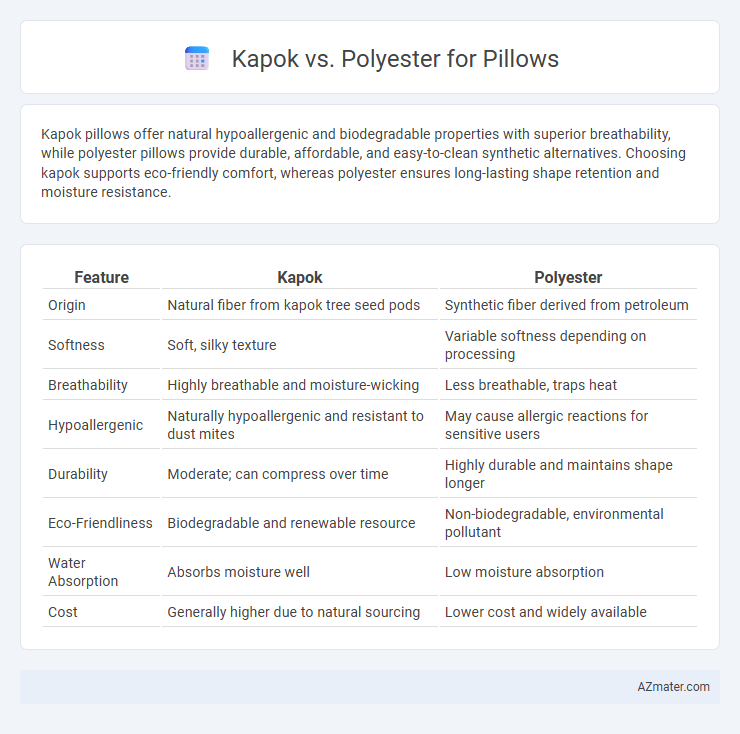Kapok pillows offer natural hypoallergenic and biodegradable properties with superior breathability, while polyester pillows provide durable, affordable, and easy-to-clean synthetic alternatives. Choosing kapok supports eco-friendly comfort, whereas polyester ensures long-lasting shape retention and moisture resistance.
Table of Comparison
| Feature | Kapok | Polyester |
|---|---|---|
| Origin | Natural fiber from kapok tree seed pods | Synthetic fiber derived from petroleum |
| Softness | Soft, silky texture | Variable softness depending on processing |
| Breathability | Highly breathable and moisture-wicking | Less breathable, traps heat |
| Hypoallergenic | Naturally hypoallergenic and resistant to dust mites | May cause allergic reactions for sensitive users |
| Durability | Moderate; can compress over time | Highly durable and maintains shape longer |
| Eco-Friendliness | Biodegradable and renewable resource | Non-biodegradable, environmental pollutant |
| Water Absorption | Absorbs moisture well | Low moisture absorption |
| Cost | Generally higher due to natural sourcing | Lower cost and widely available |
Introduction to Kapok and Polyester Pillows
Kapok pillows, made from natural fibers harvested from the kapok tree seed pods, offer lightweight, hypoallergenic, and eco-friendly alternatives to synthetic options. Polyester pillows consist of man-made fibers derived from petrochemicals, providing durability, affordability, and consistent firmness. Comparing these materials highlights differences in breathability, moisture-wicking capabilities, and sustainability important for user comfort and health.
What is Kapok?
Kapok is a natural fiber harvested from the seed pods of the kapok tree, valued for its lightweight, hypoallergenic, and biodegradable properties. Unlike polyester, which is a synthetic material derived from petrochemicals, kapok offers superior breathability and moisture resistance, making it an ideal stuffing for pillows. Its buoyant and fluffy nature provides excellent support and comfort while being an eco-friendly alternative to traditional polyester filling.
What is Polyester?
Polyester is a synthetic fiber made from petrochemicals, commonly used in pillow fillings for its durability, affordability, and resistance to wrinkles and shrinking. It offers consistent loft and hypoallergenic properties but lacks the natural breathability of kapok, a fiber derived from the seed pods of the kapok tree. While polyester pillows retain shape and support over time, they may trap heat more than kapok, affecting overall sleep comfort.
Comfort and Support Comparison
Kapok pillows offer natural breathability and a soft, cloud-like comfort due to their lightweight, fluffy fibers, making them ideal for those seeking gentle support that conforms to the head and neck. Polyester pillows provide firmer support with less airflow, resulting in a denser feel that can retain heat but offers consistent structure for spinal alignment. Comparing comfort and support, kapok excels in plush softness and temperature regulation, while polyester delivers more durable firmness and resistance to flattening over time.
Breathability and Temperature Regulation
Kapok fibers are naturally hollow, providing superior breathability and moisture-wicking properties that help pillows stay cool and dry throughout the night. Polyester, while durable and affordable, tends to trap heat and lacks the natural ventilation of kapok, leading to potential overheating during sleep. Choosing kapok for pillows ensures enhanced temperature regulation and a cooler, more comfortable sleep environment.
Hypoallergenic Properties
Kapok fiber offers natural hypoallergenic properties by resisting dust mites, mold, and mildew, making it ideal for sensitive sleepers prone to allergies. Polyester pillows can sometimes harbor dust mites and allergens due to their synthetic nature, though hypoallergenic treatments are available. Choosing kapok over polyester enhances breathability and reduces allergen accumulation, supporting a cleaner, healthier sleep environment.
Environmental Impact: Kapok vs Polyester
Kapok pillows offer a sustainable, biodegradable option derived from the seed fibers of the kapok tree, requiring minimal water and no pesticides for cultivation, significantly reducing environmental impact compared to polyester. Polyester pillows, made from petroleum-based synthetic fibers, contribute to microplastic pollution and have a high carbon footprint due to energy-intensive manufacturing processes. Choosing kapok over polyester supports eco-friendly practices by minimizing chemical use and waste, promoting a healthier planet.
Durability and Maintenance
Kapok pillows offer natural durability due to their resilient fiber structure but may break down faster than polyester when subjected to frequent compression and washing. Polyester pillows resist wear and tear better over time and maintain loft with less frequent fluffing, making them ideal for long-term use. In terms of maintenance, polyester is hypoallergenic and machine-washable, whereas kapok requires gentle hand-washing and careful drying to prevent fiber clumping and degradation.
Price Comparison
Kapok pillows typically cost more due to their natural, sustainable fibers and eco-friendly harvesting processes, often ranging from $30 to $70. Polyester pillows are generally cheaper, with prices often between $10 and $30, owing to mass production and synthetic materials. Consumers choosing between kapok and polyester must weigh higher upfront costs against durability and environmental impact.
Which Pillow Filler is Best for You?
Kapok pillow fillers offer a natural, hypoallergenic, and eco-friendly option with excellent breathability and softness, making them ideal for those seeking organic and sustainable bedding. Polyester pillows provide affordability, durability, and easy maintenance but may lack the breathability and environmental benefits of kapok. Choosing the best pillow filler depends on your preferences for natural materials, support, and care requirements.

Infographic: Kapok vs Polyester for Pillow
 azmater.com
azmater.com